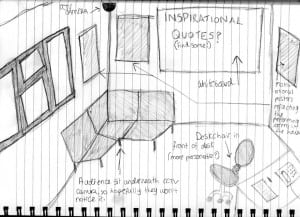Deciding what to do with my space was the hardest part of the whole process, unlike most of the other rooms and their inhabitants, I didn’t have a game plan as such, which I think came from my initial dislike of the room. I had written down ten impressions I had of the room from the first day, clearly expressing what I felt whenever I was left alone in that room –
- Isolated
- I hate waiting
- Sat in silence
- Let your standards go…
- Random rage
- Mindless banality
- Separated from the rest
- The room where nothing happens…
- This room is not interesting!
- The only truthful room.
The only observation I took that day was the last point – the waiting room is the only truthful room. It is the only room in the house that is not a façade Knowing this, I felt like I could only use the room for its intended purpose, it brought out the most inspiration in me. It would have to be something that felt corporate; it couldn’t feel like part of the home, due to how it was furnished – “An austere office room with its functional furniture does not have a homelike effect and is not intended to do so, because it is intended to put one in the mood for concentrated work. The furniture must fill the space in such a way that the impression is neither of emptiness nor of overcrowding” ((Bollnow, Otto (2011), Human Space, Hyphen Press, P.144))
I was given the idea that I could perform under the pretence of an estate agent – my room to be the office where I give the audience background information of the property, and the rest of their experience in the house would be a ‘tour’ of the house. This idea resonated with me instantly, it gave me new inspiration, like the room I despised finally made sense, and I started to become excited to work on it, rather that loathing it. Now that I was working with the rooms aesthetics rather than against it, gave me more ideas on how it could be used, and how it would be perceived by the audience, I wrote a rough script on how exactly the estate agent idea could possibly work, starting with the audience knocking on the front door, I answer it, and it proceeds from there. I had a few ideas about how I could change up the furniture in the room, so it could be perceived as both corporate, but also welcoming at the same time:
To make the room seem less bare and therefore more personable, I thought ‘inspirational’ posters in bright eye-catching colours would be a fitting substitute. On the other hand, if the poster concept did not work, I thought possibly a large mirror, or several small mirrors would add an interesting aspect to the space as it makes a room seem larger or “a kind of alternative window, not only to the outside world but on the interior”. ((Heathcoate, Edwin, (2012), the Meaning of Home, London: Frances Lincoln Ltd, P.135.))
My role would be the initiator – the person who introduces the audience to the whole performance, I would in theory be setting up what is to come, the ‘inspirational’ posters would have hints as to what the other rooms performances would be, for example – for the kitchen, the poster’s artwork was of a steaming cup of tea accompanied by rabbit ears – these aspects were not so subtle, yet from an audiences point of view would be completely unexplainable until they saw the kitchen performance.
After my ten minutes of performing, I would lead the audience out, and subject to further decisions, I would guide them either upstairs to Louise, or into the living room/cupboard room.
